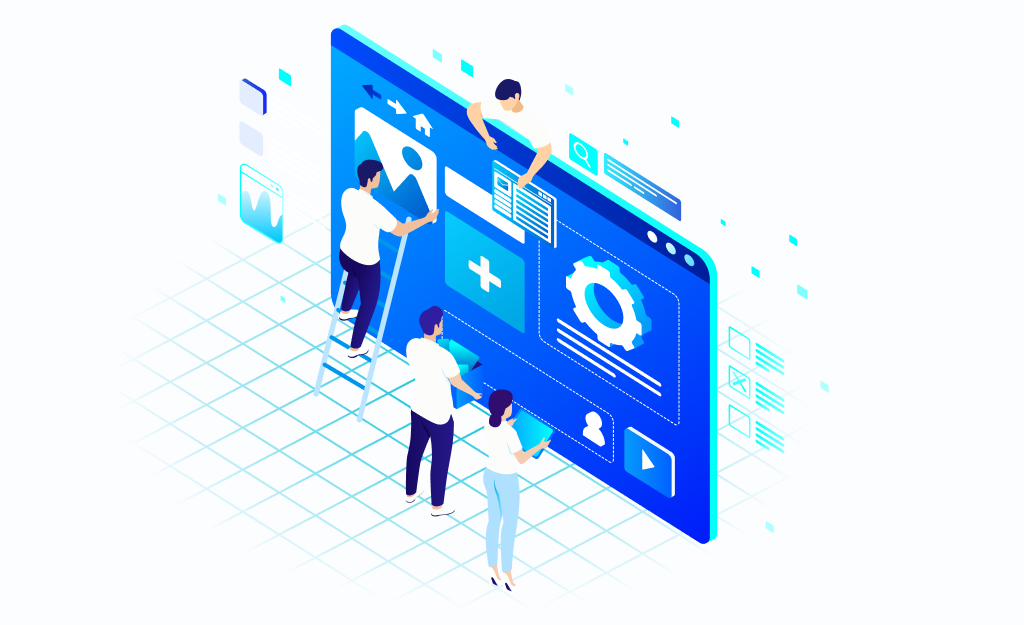
Educational App Development: Driving Innovation in EdTech
The global education landscape is evolving rapidly, with technology playing an increasingly significant role in shaping the way we learn. At the forefront of this transformation are educational apps, which have become indispensable tools for students, teachers, and institutions worldwide. In this in-depth article, we will delve into the world of educational app creation, exploring its essential aspects, and discussing how to create engaging and effective learning experiences for users. From understanding the cost of creating an educational app to finding the right company to bring your idea to life, this comprehensive guide will provide valuable insights for anyone interested in this exciting field.
Table of Contents:
The Importance of Educational Apps
Key Factors to Consider in Educational Mobile App Development
How to Create an Educational App: A Step-by-Step Guide
The Best Practices in Educational App Development
How to Choose the Right Company for Developing Educational Apps
Case Studies: Jellyfish.tech’s Success in Educational App Development
Cost of Creating Educational Apps: Factors Affecting the Budget
👉 Before we begin, if you are interested in custom educational app development services, visit this page to learn more about how Jellyfish.tech can help you create a cutting-edge educational app. 🚀
The Importance of Educational Apps
Educational apps have revolutionized the way we access and consume information, making learning more engaging, interactive, and personalized. By harnessing the power of smartphones, tablets, and other mobile devices, educational apps cater to diverse learning needs, styles, and preferences, enabling users to learn at their own pace and convenience. In today’s fast-paced and digital world, developing educational apps for mobile devices has emerged as a vital strategy for organizations looking to make a mark in the edtech industry.
Types of Educational Apps
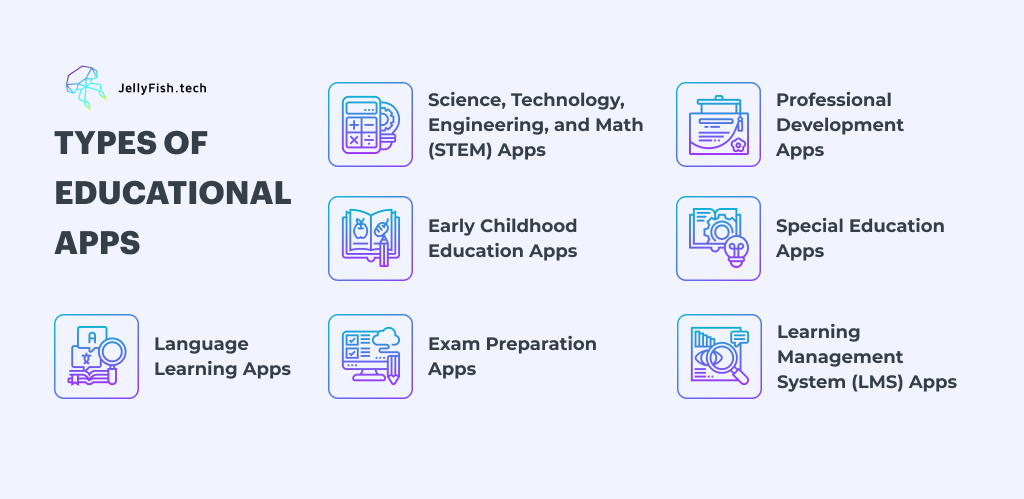
There is a wide range of educational apps available in the market, catering to various learning needs and preferences. Some of the most popular types include:
Language Learning Apps: These apps help users learn new languages through interactive lessons, quizzes, and games.
Science, Technology, Engineering, and Math (STEM) Apps: These apps focus on improving users’ understanding of STEM subjects through simulations, problem-solving exercises, and multimedia content.
Early Childhood Education Apps: Designed for young children, these apps facilitate the development of essential cognitive, motor, and social skills through fun and engaging activities.
Exam Preparation Apps: These apps help students prepare for various examinations, providing study materials, practice questions, and personalized learning plans.
Professional Development Apps: Targeting working professionals, these apps offer courses, certifications, and resources to enhance career prospects and job-related skills.
Special Education Apps: These apps cater to individuals with special needs, providing accessible learning experiences tailored to their unique requirements.
Learning Management System (LMS) Apps: These apps help educators and institutions manage, deliver, and track learning content and student progress.
Key Factors to Consider in Educational Mobile App Development
Developing an educational mobile app requires careful planning and consideration of various factors that can impact the app’s success and effectiveness in delivering educational content. Here are some key factors to consider when embarking on educational mobile app development:
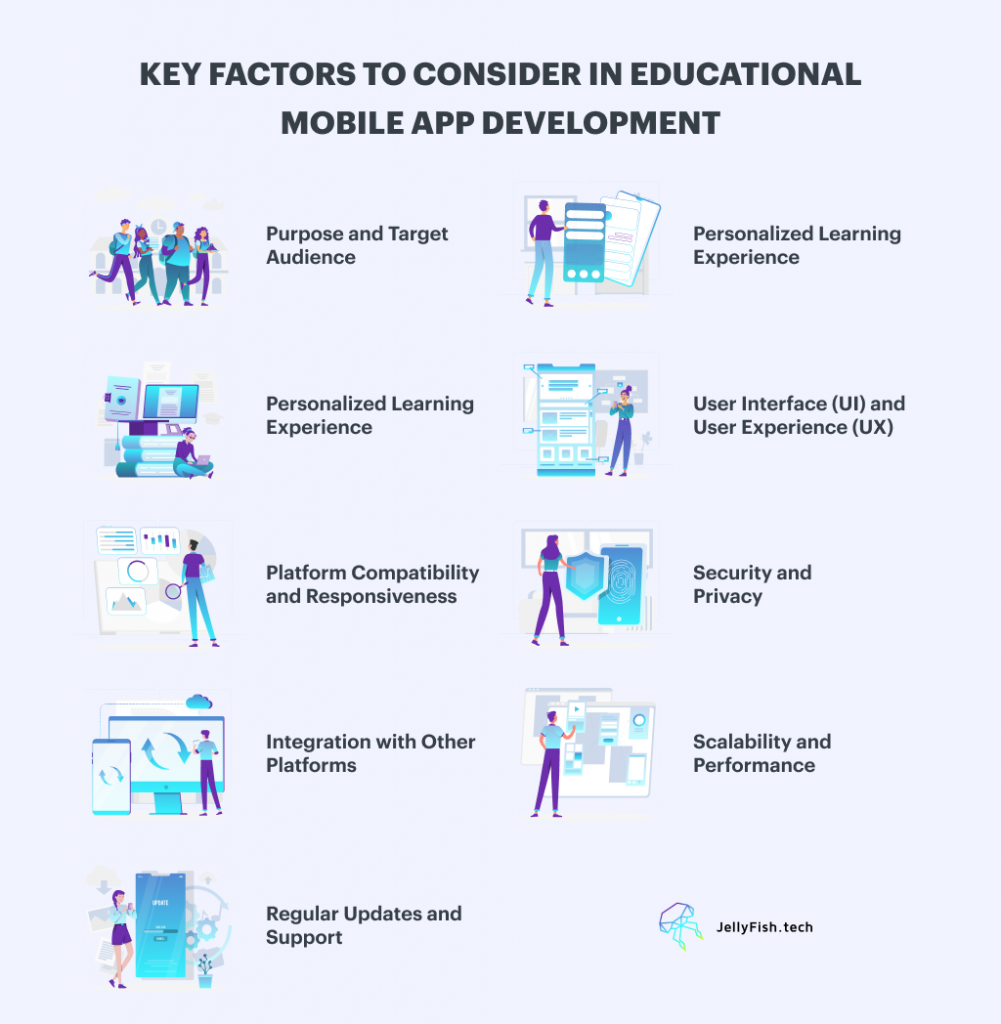
Purpose and Target Audience
Before starting the development process, clearly define the purpose of your educational app and identify the target audience. Determine whether the app is designed to teach a specific subject, develop a skill, or facilitate collaboration among learners. Understanding the specific needs and preferences of your target audience is crucial for creating an app that caters to their unique requirements and learning styles.
Engaging and Interactive Content
One of the most critical factors for a successful educational app is the quality of the content. Ensure that the content is engaging, informative, and interactive, making it easier for users to grasp concepts and retain information. Incorporate multimedia elements, such as videos, images, and animations, to create a rich and immersive learning experience. Interactive quizzes, simulations, and gamification can also enhance user engagement and motivation.
Personalized Learning Experience
A personalized learning experience is crucial for catering to the diverse needs of learners, as it allows users to progress at their own pace and focuses on their specific learning goals. Implement features that enable personalized learning paths, such as adaptive learning algorithms, progress tracking, and customized feedback. Offering a tailored learning experience can significantly improve user satisfaction and educational outcomes.
User Interface (UI) and User Experience (UX)
An intuitive, user-friendly, and visually appealing interface is essential for an educational app, as it directly impacts user engagement and satisfaction. Design your app’s UI and UX with the target audience in mind, ensuring that it is easy to navigate and accessible to users with different abilities. Prioritize clarity, readability, and consistency in design elements, such as fonts, colors, and icons.
Platform Compatibility and Responsiveness
To reach a broader audience and maximize the app’s potential, ensure that it is compatible with multiple platforms, such as iOS, Android, and web browsers. The app should also be responsive, meaning it can adapt to various screen sizes and orientations to provide an optimal user experience across different devices, such as smartphones, tablets, and desktop computers.
Security and Privacy
Protecting users’ data and privacy is a critical aspect of educational mobile app development. Implement appropriate security measures, such as secure authentication, data encryption, and regular security audits, to safeguard users’ personal information and ensure compliance with data protection regulations, such as the General Data Protection Regulation (GDPR) and the Children’s Online Privacy Protection Act (COPPA).
Integration with Other Platforms
Consider integrating your educational app with other platforms and tools commonly used by learners and educators. For instance, integration with learning management systems (LMS), social media platforms, or cloud storage services can enhance the app’s functionality and provide additional value to users.
Scalability and Performance
As your educational app gains popularity and attracts more users, it’s essential to ensure that it can scale and maintain optimal performance. Design your app’s architecture to handle increased user traffic and content, and optimize performance through regular monitoring and updates.
Regular Updates and Support
An educational app’s success is not only determined by its initial launch but also by its ability to evolve and adapt to the changing needs of its users. Plan for regular updates to address user feedback, fix bugs, and add new features or content. Additionally, provide ongoing support to users through help documentation, tutorials, and customer service channels.
Considering these key factors during the educational mobile app development process can significantly impact the app’s success and effectiveness. By focusing on the target audience’s needs, delivering engaging and personalized content, ensuring a seamless user experience.
How to Create an Educational App: A Step-by-Step Guide
Creating an educational app can be a rewarding and profitable venture, as the demand for high-quality educational tools continues to grow. In this step-by-step guide, we will explore the process of creating an educational app, from idea conception to launching it in the market.
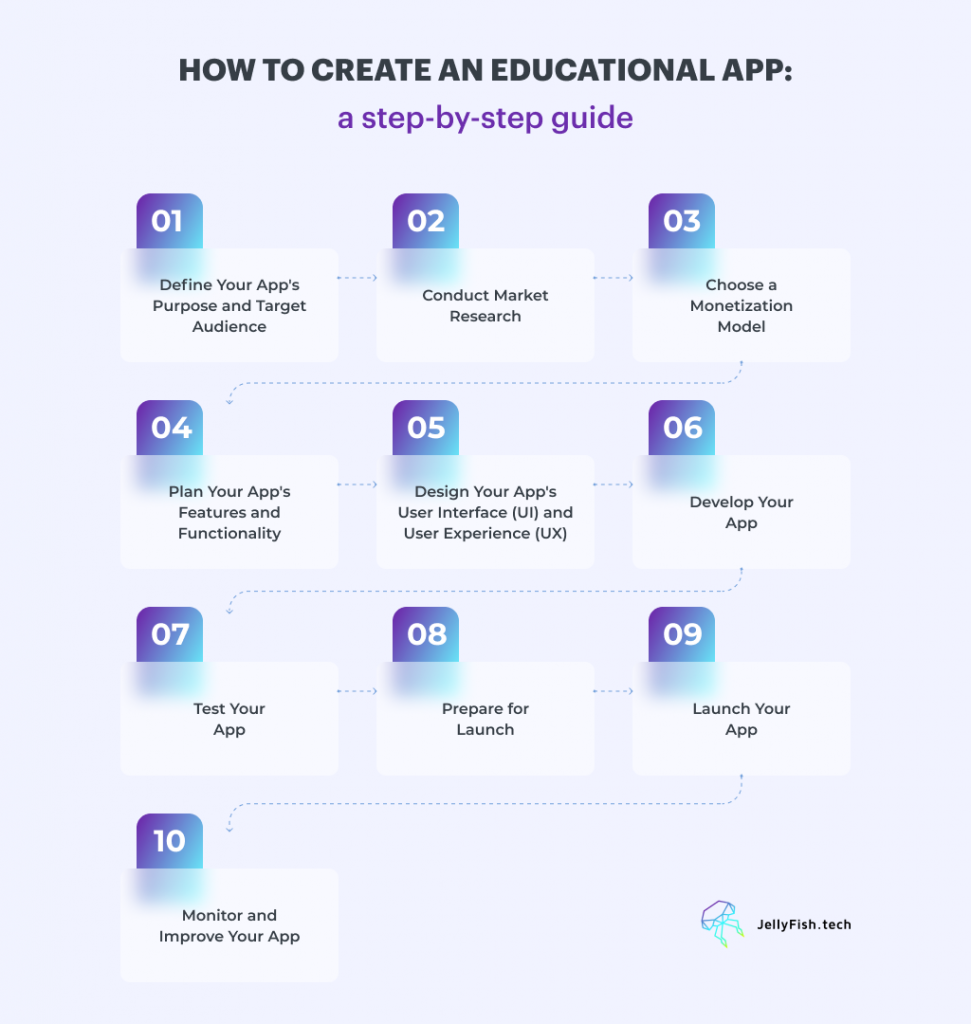
1. Define Your App’s Purpose and Target Audience
Before you start building your app, it’s essential to have a clear understanding of its purpose and target audience. Ask yourself the following questions:
- What is the primary goal of your app? Is it to teach a specific subject, help users develop a skill, or provide a platform for learning and collaboration?
- Who is your target audience? Are you targeting preschoolers, K-12 students, college students, or adult learners?
- What are the specific needs and preferences of your target audience?
Defining your app’s purpose and target audience will help you make informed decisions throughout the app development process.
2. Conduct Market Research
Market research is crucial for understanding the current state of the educational app market, identifying your competitors, and discovering potential opportunities for your app. Analyze existing educational apps in your niche, taking note of their features, pricing, user feedback, and overall success. This research will help you identify gaps in the market and tailor your app to meet the needs of your target audience.
3. Choose a Monetization Model
Deciding on a monetization model early in the development process is essential for creating a sustainable and profitable app. There are several monetization models to consider:
- Freemium: Offer a basic version of your app for free, with additional features, content, or functionality available through in-app purchases or subscriptions.
- Paid Apps: Charge users a one-time fee to download and use your app.
- In-app Advertising: Generate revenue by displaying ads within your app.
- Sponsorships and Partnerships: Partner with other companies or organizations to generate revenue through co-branding or sponsored content.
4. Plan Your App’s Features and Functionality
Based on your app’s purpose, target audience, and market research, make a list of features and functionalities that will set your app apart from the competition. Keep in mind that a simple, user-friendly interface and engaging, interactive content are essential for a successful educational app. Features to consider include:
- Interactive lessons or quizzes
- Gamification elements, such as badges or leaderboards
- Progress tracking and analytics
- Collaboration tools, such as chat or forums
- Personalized learning paths
- Integration with other platforms, such as learning management systems
5. Design Your App’s User Interface (UI) and User Experience (UX)
A well-designed UI and UX are crucial for the success of any app, especially educational ones. Work with a professional designer or use design tools like Sketch, Figma, or Adobe XD to create an intuitive, visually appealing, and easy-to-use interface. Keep the following guidelines in mind:
- Use clear, easy-to-read fonts and high-contrast colors for better readability
- Implement a consistent design language throughout the app
- Use familiar UI elements, such as buttons and navigation menus
- Make sure your app is accessible and usable by individuals with disabilities
6. Develop Your App
Once you have planned your app’s features and designed its UI/UX, it’s time to start developing the app. You can choose to develop the app in-house or outsource the development to a professional app development company. When developing your app, consider the following:
- Choose the right development platform, such as iOS, Android, or cross-platform
- Use appropriate programming languages and frameworks, such as Swift for iOS, Java or Kotlin for Android, or React Native for cross-platform development
- Ensure your app is optimized for various devices and screen sizes
- Implement proper security measures, such as data encryption and secure authentication, to protect users’ data and privacy
- Test your app thoroughly during development to identify and fix any bugs or issues
7. Test Your App
Before launching your educational app, it’s crucial to conduct thorough testing to ensure it functions correctly, provides a smooth user experience, and meets the needs of your target audience. Testing should include:
- Functional testing: Verify that all features and functionalities work as intended
- Usability testing: Test the app with real users to identify any issues with the user interface and user experience
- Compatibility testing: Ensure the app works correctly across various devices, operating systems, and screen sizes
- Security testing: Identify and address any potential security vulnerabilities
- Performance testing: Optimize the app’s performance, such as loading times and responsiveness
Gather feedback from testers and make any necessary improvements to your app based on their input.
8. Prepare for Launch
As you approach the launch date, there are several tasks to complete to ensure a successful app launch:
- Create a compelling app store listing, including a descriptive title, detailed description, screenshots, and a promotional video if possible
- Set up a website or landing page for your app, providing additional information, user support, and marketing materials
- Develop a marketing plan, including social media promotion, email marketing, influencer outreach, and press releases
- Plan for app updates and ongoing maintenance, such as bug fixes, feature improvements, and new content
9. Launch Your App
Once your app is tested, refined, and ready for launch, submit it to the appropriate app stores, such as the Apple App Store or Google Play Store. Be prepared to address any issues or bugs that users may encounter during the initial launch period.
10. Monitor and Improve Your App
After launching your app, it’s essential to monitor its performance, gather user feedback, and make improvements as needed. Track app downloads, user ratings, and reviews to identify any areas for improvement. Regularly update your app with new features, content, and bug fixes to keep users engaged and maintain a high-quality educational experience.

The Best Practices in Educational App Development
Developing an educational app that stands out in the crowded marketplace and provides a meaningful learning experience to users requires adhering to best practices. In this chapter, we’ll explore some of the best practices in educational app development, drawing from expert insights and authority sources in the EdTech industry.
Focus on the Core Learning Objectives
When designing an educational app, it is essential to prioritize the core learning objectives and ensure that the app’s features and functionalities align with these goals. The American Psychological Association (APA) emphasizes that educational technologies should be designed to support well-defined learning objectives and promote active cognitive processing for effective learning.
Implement Evidence-Based Learning Principles
Incorporating evidence-based learning principles into your app’s design can significantly improve its educational value. For instance, the Cognitive Theory of Multimedia Learning suggests that combining text, images, and audio can enhance users’ understanding and retention of information. Integrating these principles can help create a more effective and engaging learning experience for users.
Design for Accessibility
A successful educational app must cater to users with diverse needs, including those with disabilities. The Web Content Accessibility Guidelines (WCAG) provide recommendations for designing accessible digital content, such as using clear, easy-to-read fonts, high-contrast colors, and alternative text for images. Implementing accessibility features ensures that your app is inclusive and usable by a wider range of learners.
Promote Active Learning
Active learning is an essential component of effective education, as it encourages learners to engage with the content and think critically. The National Research Council highlights that educational technologies should be designed to promote active learning through features such as interactive quizzes, simulations, and collaboration tools. Incorporating these elements in your app can foster deeper understanding and knowledge retention.
Leverage Gamification Techniques
Gamification, the process of incorporating game-like elements into non-gaming contexts, has been proven to boost motivation and engagement in educational settings. Elements such as leaderboards, badges, and progress tracking can encourage users to persist in their learning and make the experience more enjoyable.
Provide Feedback and Assessment
Effective learning requires timely feedback and assessment to help learners gauge their progress and identify areas for improvement. The APA recommends that educational technologies should provide opportunities for learners to receive feedback on their performance and guide them in refining their understanding. Incorporating features such as quizzes with instant feedback, progress tracking, and analytics can help users monitor their learning and make necessary adjustments.
Ensure Data Privacy and Security
With increasing concerns about data privacy and security, educational app developers must prioritize these aspects during the development process. The Family Educational Rights and Privacy Act (FERPA) and the Children’s Online Privacy Protection Act (COPPA) are examples of regulations that govern data privacy in educational settings. Following these guidelines and implementing robust security measures can help protect users’ personal information and ensure compliance with legal requirements.
Test and Iterate
Continuous testing and iteration are essential for refining your educational app and ensuring that it meets users’ needs. Conduct usability testing with real users, gather feedback, and make improvements based on their input. Regular updates and improvements can help maintain user engagement and satisfaction while addressing any issues that arise over time.
Following best practices in educational app development can significantly improve the app’s effectiveness, user experience, and overall success. By focusing on core learning objectives, incorporating evidence-based learning principles, designing for accessibility, promoting active learning, leveraging gamification, providing feedback and assessment, ensuring data privacy and security, and continually testing and iterating, you can create an educational app that makes a positive impact on learners’ lives.
How to Choose the Right Company for Developing Educational Apps
Selecting the right company for your project is crucial for its success. Here are some factors to consider when making your choice:
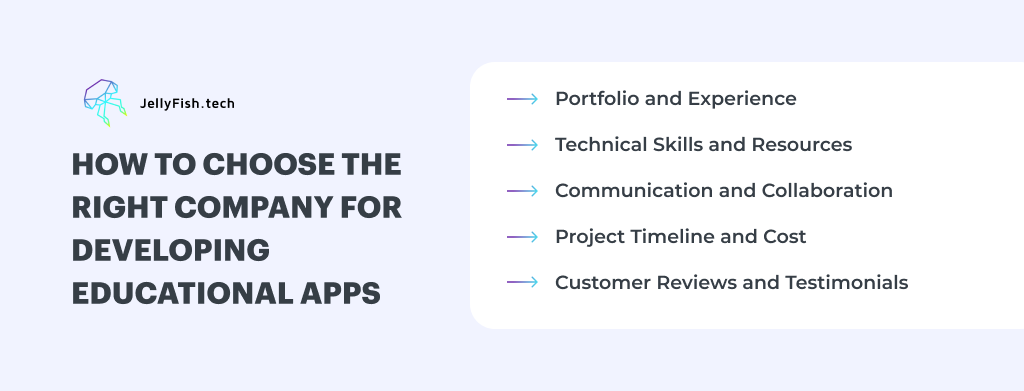
Portfolio and Experience: Examine the company’s portfolio to assess its expertise in the field. Look for projects similar to your app idea and consider their success in the market.
Technical Skills and Resources: Ensure the company has a skilled team of developers, designers, and other professionals who can handle your project’s requirements.
Communication and Collaboration: Choose a company that maintains open communication, keeps you informed about the project’s progress, and values your input.
Project Timeline and Cost: Evaluate the company’s ability to deliver the project on time and within your budget.
Customer Reviews and Testimonials: Research customer reviews and testimonials to gauge the company’s reputation and client satisfaction.
We are one of such reputable companies, which specializes in custom app development for the education sector. Jellyfish has a proven track record in the edtech industry, with successful case studies such as the Education Marketplace and SciDash. To learn more about those case studies read the next chapter.
Case Studies: Jellyfish.tech’s Success in Educational App Development
Jellyfish.tech has a proven track record in educational app development, as evidenced by our successful projects in the edtech space. Here are two notable case studies:
Education Marketplace
Our team developed a comprehensive education marketplace platform, offering a range of online courses, workshops, and resources for students and professionals. This platform connects learners with educators and institutions, providing a seamless learning experience.
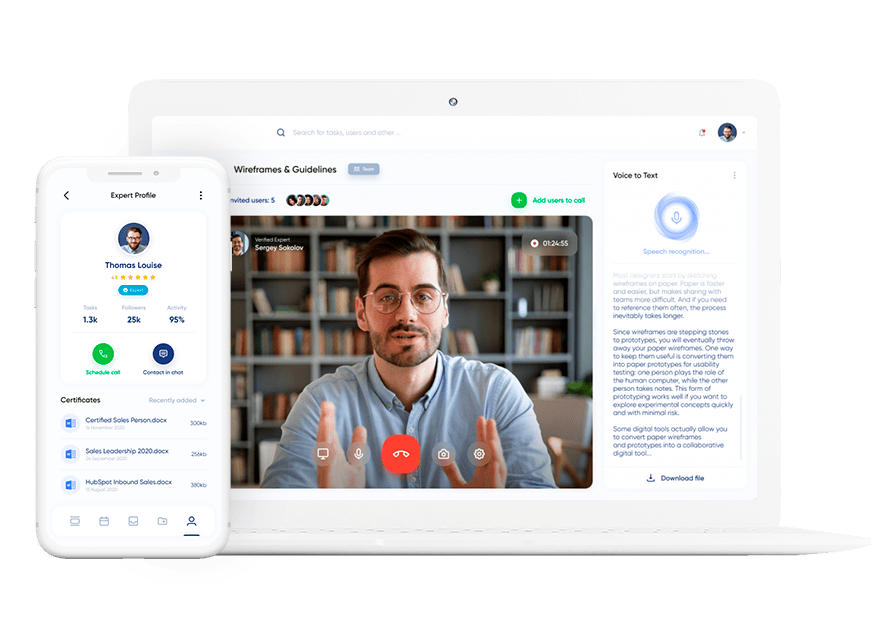
Key features of the Education Marketplace project include:
- A user-friendly interface that makes navigation and course discovery easy and efficient.
- A robust search functionality, enabling users to find relevant courses based on their preferences and needs.
- A secure payment system, ensuring a safe and hassle-free transaction process.
- Integrated communication tools, facilitating interaction between learners and educators.
This project involved the development of both a web application and a mobile app, demonstrating our expertise in multi-platform educational app development. Learn more at https://jellyfish.tech/cases/education-marketplace/.
SciDash
In the SciDash project, we created a powerful scientific data management platform that helps researchers and institutions manage, store, and share their research data. This innovative solution addresses the challenges faced by the scientific community in organizing, accessing, and collaborating on research data.
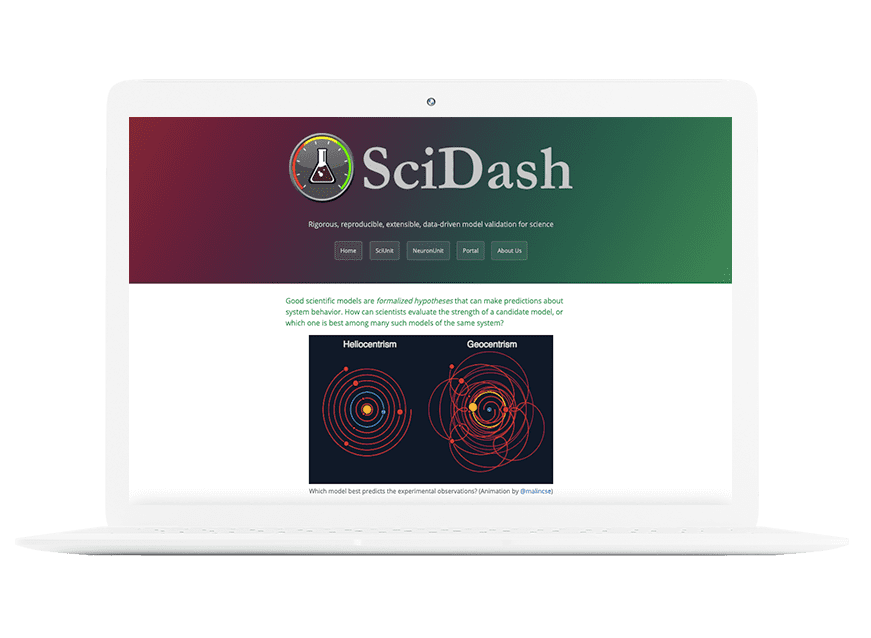
Some of the standout features of the SciDash platform include:
- A secure, cloud-based data storage system, providing easy access to research data from anywhere and at any time.
- A flexible data organization system, allowing users to categorize, tag, and filter their data for quick retrieval.
- Collaboration tools, enabling researchers to work together on projects, share data, and exchange ideas.
- Integration with popular third-party tools and services, offering users a seamless and efficient research data management experience.
The SciDash case study demonstrates Jellyfish.tech’s proficiency in developing cutting-edge technology solutions that cater to specific industry needs, in this case, addressing the challenges faced by the scientific community. Learn more at https://jellyfish.tech/cases/scidash/.
To explore our expertise in edtech app development further, visit our dedicated service page at https://jellyfish.tech/expertise/edtech/.
Cost of Creating Educational Apps: Factors Affecting the Budget
The cost of creating an educational app can vary significantly depending on various factors, but the average cost for EdTech app development typically ranges from $30,000 to $150,000, as reported by Reinvently, a mobile app development agency. This cost range takes into account factors such as app complexity, design, platform selection, and third-party integrations. In the following sections, we will delve deeper into the factors affecting the budget for educational app development to help you better understand the expenses involved in creating an app tailored to your specific needs.
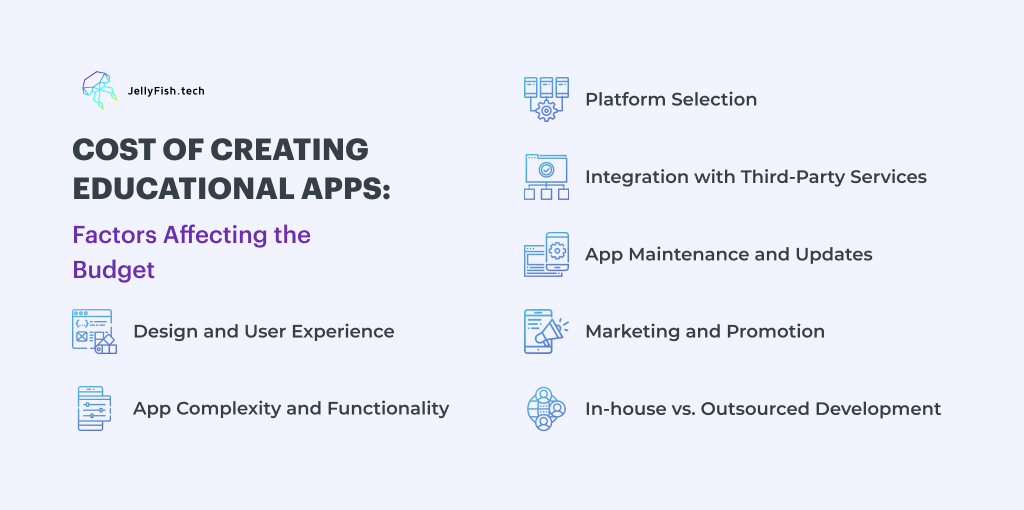
App Complexity and Functionality
One of the primary factors affecting the cost of app development is the complexity and the number of features included in the app. A basic app with limited features, such as flashcards or simple quizzes, will be less expensive to develop than an app with more advanced features like interactive lessons, gamification elements, or personalized learning paths. The more complex the app, the more time and resources it will require for development, which directly impacts the overall cost.
Platform Selection
The choice of platforms on which your app will be available also influences the cost of development. Developing an app for a single platform (either iOS or Android) will typically be less expensive than creating a cross-platform app compatible with both operating systems. Cross-platform development requires additional resources, tools, and expertise, which can increase the overall cost.
Design and User Experience
The design and user experience of your app play a significant role in its success and also impact the development cost. Customized designs, animations, and high-quality visuals can enhance the user experience but also require more time and effort from designers, resulting in higher costs. On the other hand, using pre-built templates or simpler designs may be more cost-effective but might not provide the same level of user engagement and satisfaction.
Integration with Third-Party Services
If your educational app requires integration with third-party services, such as learning management systems, payment gateways, or social media platforms, the cost of development will likely increase. Integrating these services can be time-consuming and may require additional resources or specialized expertise, which can add to the overall cost.
App Maintenance and Updates
The cost of creating an educational app doesn’t end with its launch. Regular updates, bug fixes, and new features are essential to maintaining a high-quality app that meets users’ evolving needs. The ongoing costs of app maintenance and updates should be factored into your budget. Additionally, the more complex your app, the more expensive it will be to maintain and update.
Marketing and Promotion
Developing an educational app is just the beginning. To ensure its success, you’ll need to invest in marketing and promotion. The cost of marketing can vary widely depending on the strategies you choose, such as social media advertising, email campaigns, influencer partnerships, or public relations efforts. Be sure to allocate a portion of your budget for marketing to help your app gain visibility and attract users.
In-house vs. Outsourced Development
Finally, the cost of developing an educational app will depend on whether you choose to develop the app in-house or outsource the development to a professional app development company. In-house development can provide more control over the process but may require hiring or training developers, designers, and other team members, which can be costly. Outsourcing app development can save on some costs, but it’s essential to carefully select a reliable and experienced development company to ensure quality results.
The Future of the Field
The world of educational app development will continue to evolve, driven by emerging technologies and changing user preferences. Some key trends to watch for include:
Artificial Intelligence (AI) and Machine Learning (ML): AI and ML will enable more personalized and adaptive learning experiences, tailoring content to individual users’ needs.
Virtual Reality (VR) and Augmented Reality (AR): VR and AR will create immersive learning environments, enhancing user engagement and knowledge retention.
Blockchain Technology: Blockchain can help verify and secure academic credentials, streamlining admissions and recruitment processes.
Learning Analytics: The use of data-driven insights will help educators, learners, and institutions make informed decisions, improving learning outcomes.
Internet of Things (IoT): IoT devices can facilitate real-time data collection, enabling more effective monitoring and assessment of learners’ progress.
Personalized Learning: As technology advances, personalized learning experiences will become more sophisticated, taking into account individual learning styles, preferences, and performance.
Collaborative Learning: Educational apps will increasingly promote collaborative learning experiences, connecting students and educators globally and fostering a sense of community.
Accessibility and Inclusivity: The development of more accessible and inclusive educational apps will cater to a broader range of users, including individuals with disabilities and diverse learning needs.
Conclusion
The educational app development landscape is dynamic and rapidly growing, with immense potential to transform the way we learn and acquire knowledge. By understanding the intricacies of educational mobile app development and partnering with a reputable company, you can create an engaging, effective, and successful learning app that caters to your target audience’s needs.
Embarking on an educational app development journey requires thorough research, planning, and execution. However, the rewards are immense, as you contribute to the future of learning and make a lasting impact on the lives of learners worldwide.
Are you ready to bring your educational app idea to life? 👉 Get in touch with us for custom educational app development services and let our team of experts help you create the perfect learning solution for your target audience. Our experience in the edtech industry, combined with our dedication to delivering high-quality results, make us the ideal partner for your educational app development project. Don’t wait – explore the world of educational app development today and empower the future of learning.




